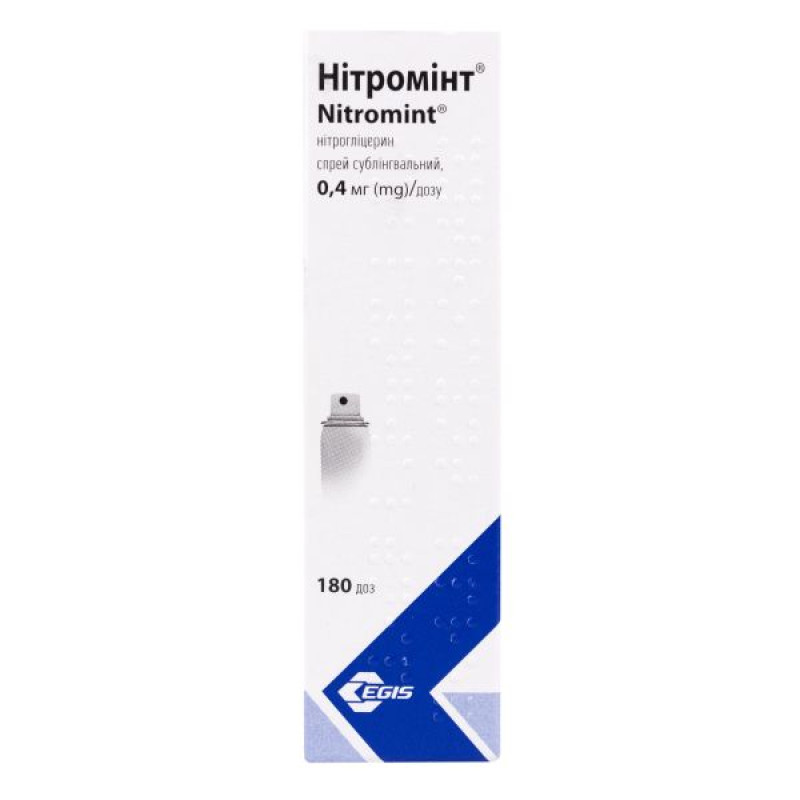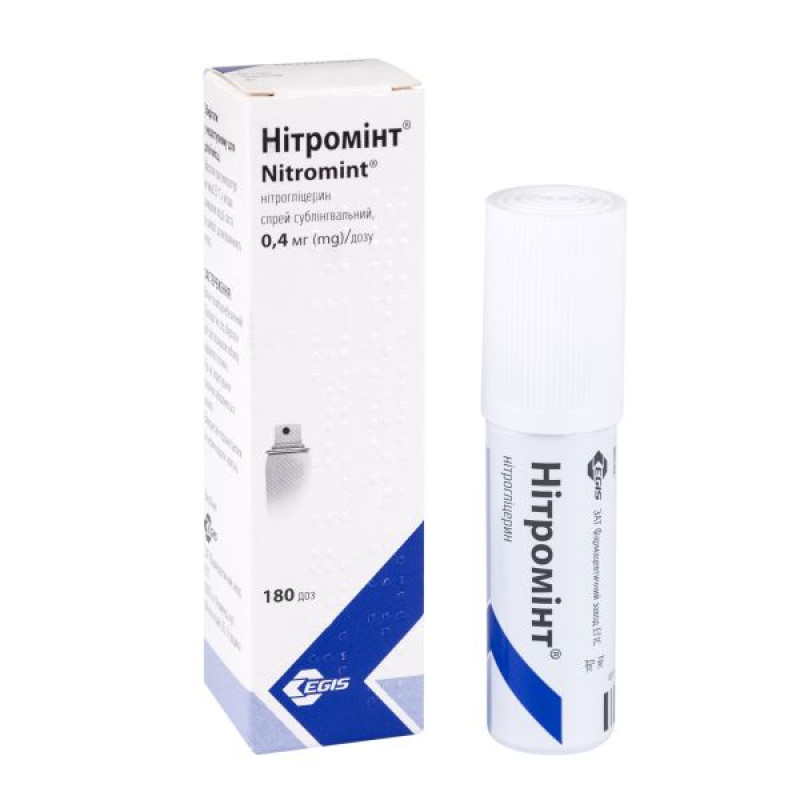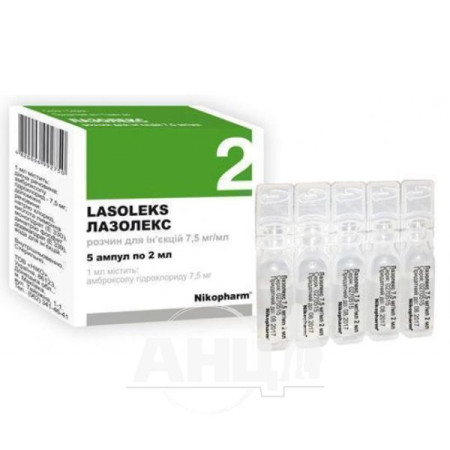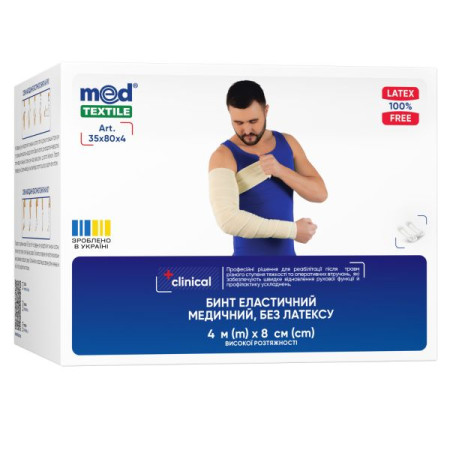Nitromint spray dosed sublingual 0.4 mg/1 dose canister 180 doses No. 1
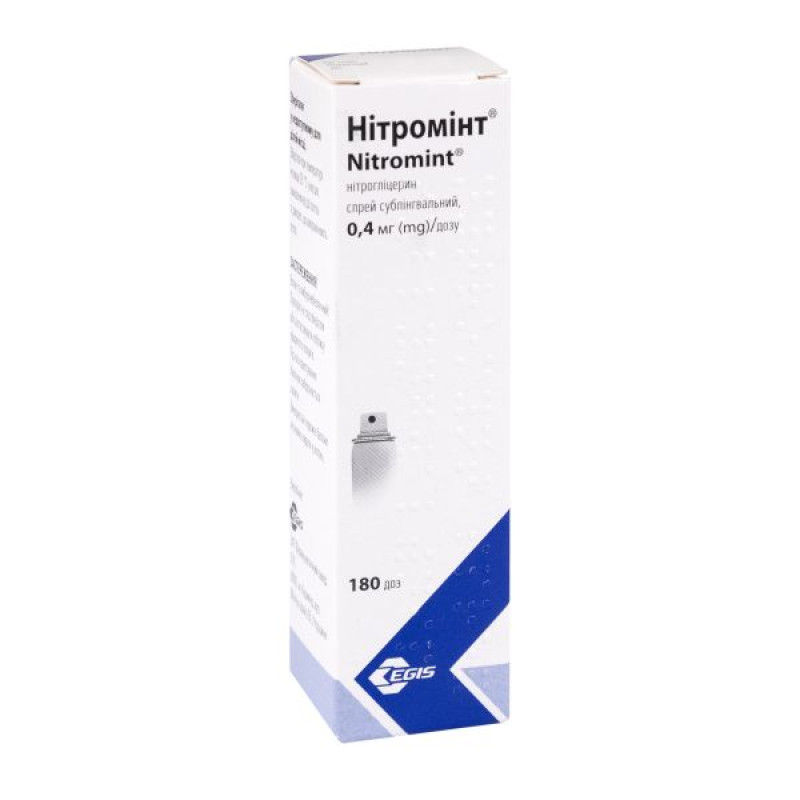
Instructions Nitromint spray dosed sublingual 0.4 mg/1 dose canister 180 doses No. 1
Composition
active ingredient: nitroglycerin;
1 cylinder contains 8 g of 1% nitroglycerin solution in ethanol, which corresponds to 0.08 g of nitroglycerin;
1 dose contains 0.4 mg of nitroglycerin;
excipients: propylene glycol.
Dosage form
Sublingual spray.
Main physicochemical properties: colorless or almost colorless solution, does not contain foreign particles.
Pharmacotherapeutic group
Peripheral vasodilator. Antianginal agent.
ATX code C01D A02.
Pharmacological properties
Pharmacodynamics.
Nitroglycerin is an organic nitrate compound that has a dilating effect on arteries and veins.
The postcapillary chains of peripheral vessels, large arteries, and especially areas of coronary vessels that are still reactive are more sensitive to nitroglycerin than resistant (precapillary) vessels.
Relaxation of the smooth muscles of the vascular wall causes vasodilation, which reduces venous blood flow to the heart (preload) and vascular resistance of the large circle of blood circulation (afterload). This reduces the work of the heart and the need for myocardial oxygen. The blood supply to the most vulnerable to ischemia subendocardial layers of the walls is improved, as well as regional wall mobility and stroke volume of the heart. The expansion of the large arteries located near the heart reduces systemic and pulmonary vascular resistance.
Nitroglycerin also has a muscle relaxant effect on the smooth muscles of the bronchi, biliary and urinary tracts, gallbladder, large and small intestines, and sphincters.
Nitroglycerin is thought to exert these effects by binding to so-called nitrate receptors located on the surface of smooth muscle cells. In smooth muscle, nitroglycerin undergoes enzymatic conversion to form nitric oxide (NO), which stimulates soluble guanylate cyclase, which is responsible for the formation of cyclic guanosine-3'5'-monophosphate (cGMP), which relaxes smooth muscle.
Pharmacokinetics.
When administered sublingually, nitroglycerin is rapidly absorbed from the oral cavity and enters the systemic circulation directly (the effect of the first passage through the liver is eliminated). Bioavailability has significant inter- and intra-subject differences and averages about 39%. The onset of action of nitroglycerin occurs very quickly; the effect develops within 1–1.5 min and lasts for 30 min. The maximum plasma level is reached within 4 min. When administered sublingually, the half-life of nitroglycerin is almost 2.5–4.4 min. Nitroglycerin, which has entered the bloodstream, binds to erythrocytes and accumulates in the walls of blood vessels. Binding to plasma proteins is almost 60%. The main route of excretion is with urine in the form of metabolites; less than 1% of the administered dose is excreted unchanged.
Indication
Treatment of angina attacks.
Prevention of angina attacks; physical exertion or emotional stress that can trigger angina attacks.
Adjuvant therapy in cases requiring emergency care, in acute left ventricular failure (cardiac asthma).
Lowering blood pressure in acute myocardial infarction.
Prevention of coronary vasospasm caused by cardiac catheterization during coronary angiography.
Contraindication
Hypersensitivity to the active substance, other nitrate derivatives or to any component of the drug.
Acute vascular insufficiency (shock, collapse).
Arterial hypotension (systolic blood pressure (BP) below 100 mm Hg, diastolic BP below 60 mm Hg).
Cardiogenic shock.
Acute myocardial infarction with low filling pressure.
Left ventricular failure with low filling pressure.
Angina pectoris caused by hypertrophic obstructive cardiomyopathy.
Constrictive pericarditis.
Tamponade of the pericardial cavity.
Aortic and mitral stenosis.
Cerebral ischemia.
Angle-closure glaucoma with high intraocular pressure.
Bradycardia (less than 50 beats/min).
Due to the effect of Nitromint® on the metabolic process of nitric oxide/cyclic guanosine monophosphate (cGMP), phosphodiesterase inhibitors (e.g. sildenafil, vardenafil, tadalafil) may potentiate the antihypertensive effects of nitrates, therefore their concomitant use with compounds that form nitric oxide and nitrates is contraindicated.
Any condition accompanied by increased intracranial pressure (cerebral hemorrhage and traumatic brain injury).
Primary pulmonary hypertension (since hyperemia of the hypoventilated alveolar area can lead to hypoxia). Patients with cardiovascular disease, with a tendency to orthostatic circulatory disorders, are at particular risk.
Severe anemia.
Concomitant use with riociguat and soluble guanylate cyclase stimulants.
Interaction with other medicinal products and other types of interactions
It is contraindicated to prescribe Nitromint® simultaneously with cGMP-specific phosphodiesterase type 5 inhibitors used to treat erectile dysfunction (e.g. sildenafil, vardenafil, tadalafil), as the antihypertensive effect of Nitromint® may be increased.
other vasodilators and antihypertensive drugs (beta-blockers, calcium channel blockers); neuroleptics, tricyclic antidepressants (possible increase in the antihypertensive effect of nitroglycerin);
dihydroergotamine (the serum level and effect of dihydroergotamine increase);
heparin (reduction of the effect of heparin).
Patients who have previously received nitrates (e.g. isosorbide dinitrate, isosorbide mononitrate) may require higher doses of nitroglycerin.
Nitromint® can be used with other nitrate-containing medications, but caution should be exercised to avoid overdose. Sublingual nitroglycerin tablets should not be used as an adjunct to Nitromint® for the treatment of angina attacks.
Phenobarbital activates the metabolism of nitrates in the liver. Alpha-adrenomimetics, histamine, pituitrin, corticosteroids, central nervous system (CNS) stimulants, bee venom, snake venom, sunlight reduce the antianginal effect of nitroglycerin. Salicylates increase the level of nitroglycerin in the blood, barbiturates accelerate its metabolism. Donors of sulfhydryl groups (captopril, acetylcysteine, unitiol) restore reduced sensitivity to nitroglycerin.
The consumption of alcoholic beverages while using the drug is strictly prohibited.
N-acetylcysteine may potentiate the vasodilatory effect of nitroglycerin.
Dihydroergotamine (may increase serum concentrations of dihydroergotamine and increase its vasoconstrictor effect, which may reduce the effect of nitroglycerin). This requires special attention in patients with coronary heart disease, since the combined use of dihydroergotamine and nitroglycerin may lead to narrowing of the coronary vessels.
Nonsteroidal anti-inflammatory drugs, except acetylsalicylic acid, may reduce the therapeutic effect of nitroglycerin.
Concomitant administration of nitroglycerin with amifostine and acetylsalicylic acid may increase blood pressure and reduce the effect of nitroglycerin.
The possibility of tolerance to the effects of nitroglycerin should be considered when it is used in conjunction with long-acting nitrate drugs.
The use of nitroglycerin with riociguat and soluble guanylate cyclase stimulants may cause hypotension.
Application features
Particular caution and close medical monitoring should be exercised in patients with a tendency to postural hypotension and patients with increased intracranial pressure.
Use with caution in patients with migraine.
Individual sensitivity of patients to nitrates can vary greatly, so this should always be taken into account when selecting the dose of the drug.
Increasing the dose may lead to tolerance.
The consumption of alcoholic beverages while using the drug is strictly prohibited.
Nitroglycerin increases the urinary excretion of catecholamines and vanillyl-mandelic acid.
The drug contains 79.2 vol. % ethanol (alcohol). Each dose of the spray contains 0.0396 g of alcohol. Its use can be dangerous in liver diseases, alcoholism, epilepsy, brain injuries and other diseases of the central nervous system, for pregnant women and children. Nitroglycerin can change or enhance the effects of other drugs.
The drug contains propylene glycol and may cause irritation of the mucous membrane.
It is necessary to take the drug with caution, taking into account the risk and benefit, in the following cases: primary pulmonary hypertension (with hyperemia of alveolar areas with reduced ventilation, which can lead to hypoxia); uncontrolled hypovolemia; patients with heart failure with normal or low pressure in the pulmonary artery; toxic pulmonary edema; severe anemia; hyperthyroidism; cerebral circulation disorders; severe renal failure (risk of developing methemoglobinemia). Patients with coronary artery disease are particularly at risk in this regard.
It should be used with caution in patients with severe cerebral atherosclerosis, elderly patients, and patients with aortic or mitral stenosis.
During treatment, visiting baths, saunas, and hot showers are contraindicated.
Nitroglycerin should be used with caution in patients with severe hypotension (systolic blood pressure below 90 mm Hg) and in patients with cardiogenic shock, unless sufficiently high pressure for left ventricular failure is provided by an intraaortic balloon pump or positive inotropic agents.
Nitroglycerin should be used with caution in patients with cerebrovascular disease, as symptoms of these diseases may be caused by hypotension.
Hypotension with bradycardia may occur in patients with myocardial infarction; this phenomenon is thought to be reflex-mediated.
Particular caution is required if nitroglycerin is prescribed to patients with severe liver or kidney disease, hypothyroidism, mitral prolapse, hypothermia, and in the case of malnutrition, with a recent history of myocardial infarction.
Caution is required when treating patients with arterial hypoxia due to severe anemia (including induced forms of G6PD deficiency), since the biotransformation of glyceryl trinitrate is reduced in such patients.
Patients with angina pectoris, myocardial infarction, or cerebral ischemia often suffer from lower airway abnormalities (especially alveolar hypoxia). Caution is required when using in patients with hypoxemia and ventilation/perfusion disorders due to lung disease. In patients with alveolar hypoventilation, vasoconstriction occurs in the lungs to shift perfusion from areas of alveolar hypoxia to better ventilated areas of the lung (Euler-Lillestrand mechanism).
As a potent vasodilator, glyceryl trinitrate can reverse this protective vasoconstriction and thus lead to increased perfusion of poorly ventilated areas, worsening the ventilation/perfusion imbalance, and further decreasing the arterial partial pressure of oxygen.
Nitroglycerin may lower blood oxygen levels in patients with lung disease or cor pulmonale.
If angina symptoms do not disappear after three doses, the patient should seek emergency medical attention.
Use during pregnancy or breastfeeding
Pregnancy.
The use of the drug during pregnancy is possible only if the expected benefit to the mother outweighs the potential risk to the fetus or child.
Breast-feeding.
It is not known whether nitroglycerin metabolites are excreted in breast milk.
Therefore, before prescribing nitroglycerin treatment, the benefits and risks for the mother and child should be weighed, and if the risk outweighs the benefits, breastfeeding should be discontinued.
Fertility.
Animal studies do not indicate harmful effects of nitroglycerin on fertility. However, there are no data from human studies.
The ability to influence the reaction speed when driving or working with other mechanisms
At the beginning of treatment - for a period to be determined individually - driving or operating complex mechanisms is prohibited. Later, restrictions may be reduced depending on the patient's individual response to the drug.
Glyceryl trinitrate, especially at the beginning of treatment or during dose adjustment, may impair reaction time or, in rare cases, may cause orthostatic hypotension and dizziness (and, in exceptional cases, syncope may occur after overdose). Patients experiencing these effects should refrain from driving or operating machinery.
Method of administration and doses
Treatment of angina attacks.
During an angina attack, 1 dose (1 injection = 400 micrograms) should be administered under the tongue.
If symptoms persist, the dose may be repeated at 5-minute intervals, but no more than 3 doses should be administered.
If the attack does not stop after this, you should immediately consult a doctor. The patient should be in a sitting position to prevent the development of symptoms of postural hypotension.
Prevention of angina attacks.
To prevent angina attacks during exercise or in other anticipated situations, 1 dose (1 injection) (400 micrograms) under the tongue shortly before the anticipated exercise is recommended.
Acute left ventricular failure (cardiac asthma).
In the treatment of non-hypotensive patients with acute left ventricular failure (i.e. systolic blood pressure > 100 mm Hg), 400 mcg of nitroglycerin, i.e. 1 dose (injection) is administered sublingually and repeated after 5–10 min. The total number of injections should not exceed three doses with careful monitoring of the patient's clinical condition, including blood pressure. The patient may then be switched to intravenous therapy or another vasodilator, depending on the clinical condition.
Before coronary angiography: to prevent coronary vasospasm, a dose of 1-2 injections (0.4-0.8 mg) is recommended.
Lowering blood pressure in acute myocardial infarction.
The recommended dose is 0.4-1.2 mg, i.e. 1-3 injections while monitoring blood circulation (systolic blood pressure should exceed 100 mm Hg).
According to available information, dose adjustment is not required for patients with renal or hepatic impairment.
Elderly patients.
Hypotension and dizziness may be a particular problem with nitrates in elderly patients. Patients are advised to sit while taking the sublingual spray.
Method of administration.
Nitromint® spray comes in a clear plastic bottle.
The cylinder should be kept in an upright position.
There is no need to shake the bottle before using the drug.
Before first use, the canister dispenser must be filled. To do this, remove the protective cap and press the dispenser several times until a spray appears. If the canister has not been used for a long time, the filling process must be repeated.
When using Nitromint® spray, the dosing valve should be held in a vertical position as close to the mouth as possible, and the dose of the drug should be injected under the tongue.
The spray cannot be inhaled, so you should hold your breath while spraying the drug.
During application, the patient should sit upright.
The location of the dispenser opening is easily determined by touch, which helps with nighttime use.
Children
There is no experience with the use of the drug in pediatric practice, therefore the drug is not used in children (under 18 years of age).
Overdose
Overdose of the drug may increase known adverse reactions (headache, severe hypotension, tachycardia, dizziness, flushing, vomiting, diarrhea). When using very high doses, increased intracranial pressure with cerebral symptoms, methemoglobinemia, cyanosis, dyspnea and tachypnea are possible. Additional effects from the gastrointestinal tract, such as colic and diarrhea, have also been reported.
Overdose treatment.
In case of overdose, the clinical status of the patient should be assessed, including vital signs and mental status, and cardiovascular and respiratory support should be provided. In the case of mild hypotension, it may be sufficient to place the patient in the supine position with the legs elevated.
In case of severe overdose, measures similar to those used in intoxication and shock should be taken (administration of fluids, norepinephrine and/or dopamine). The use of epinephrine (adrenaline) is contraindicated.
In the event of methemoglobinemia, the following antidotes and measures are indicated:
Vitamin C: 1 g orally in the form of tablets or 1 g intravenously in the form of a solution of sodium salt of ascorbic acid.
Methylene blue: 1-2 mg/kg body weight of 1% solution, intravenously, over 5 minutes, if the patient does not have G-6-PD deficiency.
Toluidine blue: initial dose 2-4 mg/kg intravenously, then 2 mg/kg again.
Oxygen therapy, hemodialysis, blood transfusion.
Side effects
Blood and lymphatic system disorders: methemoglobinemia.
Mental disorders: feelings of agitation, anxiety, restlessness may occur.
From the side of the central nervous system: headache, dizziness, drowsiness, syncope, cerebral ischemia, blurred vision, psychotic reactions, inhibition, disorientation.
From the cardiovascular system.
Occasionally, the first dose, particularly an increased first dose, may cause a decrease in blood pressure and/or postural hypotension with marked tachycardia, dizziness or weakness.
If blood pressure is excessively lowered, treatment with Nitromint® may aggravate angina symptoms (paradoxical reaction to nitrates).
Sometimes collapse may occur, accompanied by bradyarrhythmia and loss of consciousness; feeling hot; cyanosis; pallor.
Respiratory system: respiratory failure.
From the digestive tract:
nausea, vomiting, dry mouth, abdominal pain, diarrhea, heartburn, halitosis.
Skin and subcutaneous tissue disorders: redness, allergic skin reactions; hypersensitivity reactions; exfoliative dermatitis.
Immune system disorders: allergic reactions, including skin rash, itching; anaphylactic shock.
General disorders: moderate transient burning sensation in the throat; taste disturbance (metallic taste in the mouth); headache; progressive hypotension; hot flashes; palpitations; hypothermia; exacerbation of glaucoma, asthenia. These symptoms are transient and disappear after a few minutes.
Expiration date
3 years.
The drug should not be used after the expiration date indicated on the package.
Storage conditions
Store at a temperature not exceeding 25 °C in a place protected from light and heat sources. Keep out of the reach of children.
Flammable and explosive!
The drug should not be stored or used near open flames.
Smoking is prohibited when using the cylinder.
Used, empty cylinders must not be thrown into a fire.
Packaging
10 g (180 doses) of spray solution in an aluminum can with a dosing device, with a spray head and a protective cap, in a cardboard box.
Vacation category
According to the recipe.
Producer
CJSC Pharmaceutical Plant EGIS, Hungary.
Address
9900 Kermend, Matyas Kirai Street 65, Hungary.
There are no reviews for this product.
There are no reviews for this product, be the first to leave your review.
No questions about this product, be the first and ask your question.







